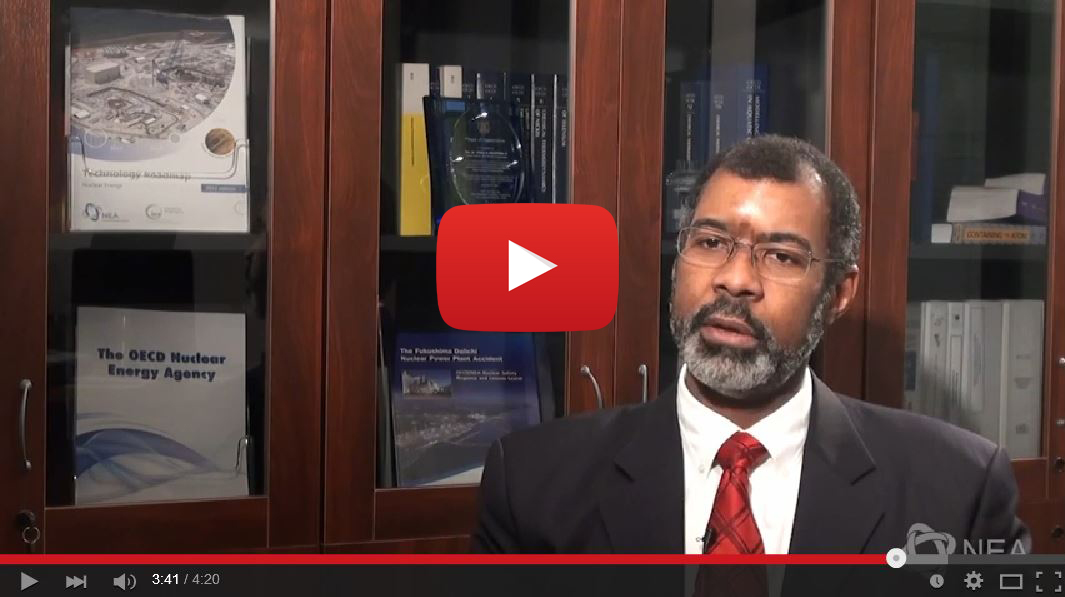
On 11 March 2011, Japan endured one of the worst combined natural disasters in its history when a massive earthquake struck its eastern coast and was followed by a tsunami. These combined natural disasters were also at the origin of Fukushima Daiichi nuclear power plant accident, which marked a turning point in terms of how nuclear safety is evaluated and ensured. The new NEA report, Five Years after the Fukushima Daiichi Accident: Nuclear Safety Improvements and Lessons Learnt, discusses actions taken and those underway in NEA member countries. NEA Director‑General William D. Magwood, IV, and NEA experts reflect on the actions undertaken by the NEA and its member countries at the national and international levels to improve nuclear safety and to implement the lessons learnt from the accident. Watch the video here: www.oecd-nea.org/fukushima/2016/video/
|
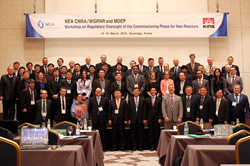 Regulatory oversight of the commissioning of new reactors
Regulatory oversight of the commissioning of new reactors
On 14-15 March 2016, the NEA Working Group on the Regulation of New Reactors (WGRNR) and the Multinational Design Evaluation Programme (MDEP), in collaboration with the Korean Institute of Nuclear Safety (KINS), held their first joint workshop. During the two-day workshop, in Gyeongju, Korea, 68 regulators and experts from 15 countries tackled 11 major issues which were identified as being challenging or safety-significant during the commissioning phase for new reactors. After a thorough review of the commissioning activities of the MDEP design-specific working groups, the participants discussed lessons learnt, commendable practices and open challenges concerning the commissioning of new nuclear power plants. They also agreed on messages to be conveyed to industry stakeholders. A report will be prepared based on the workshop discussions and will propose commendable practices to help nuclear regulatory organisations develop their commissioning oversight programme as well as plan and perform their commissioning oversight activities.
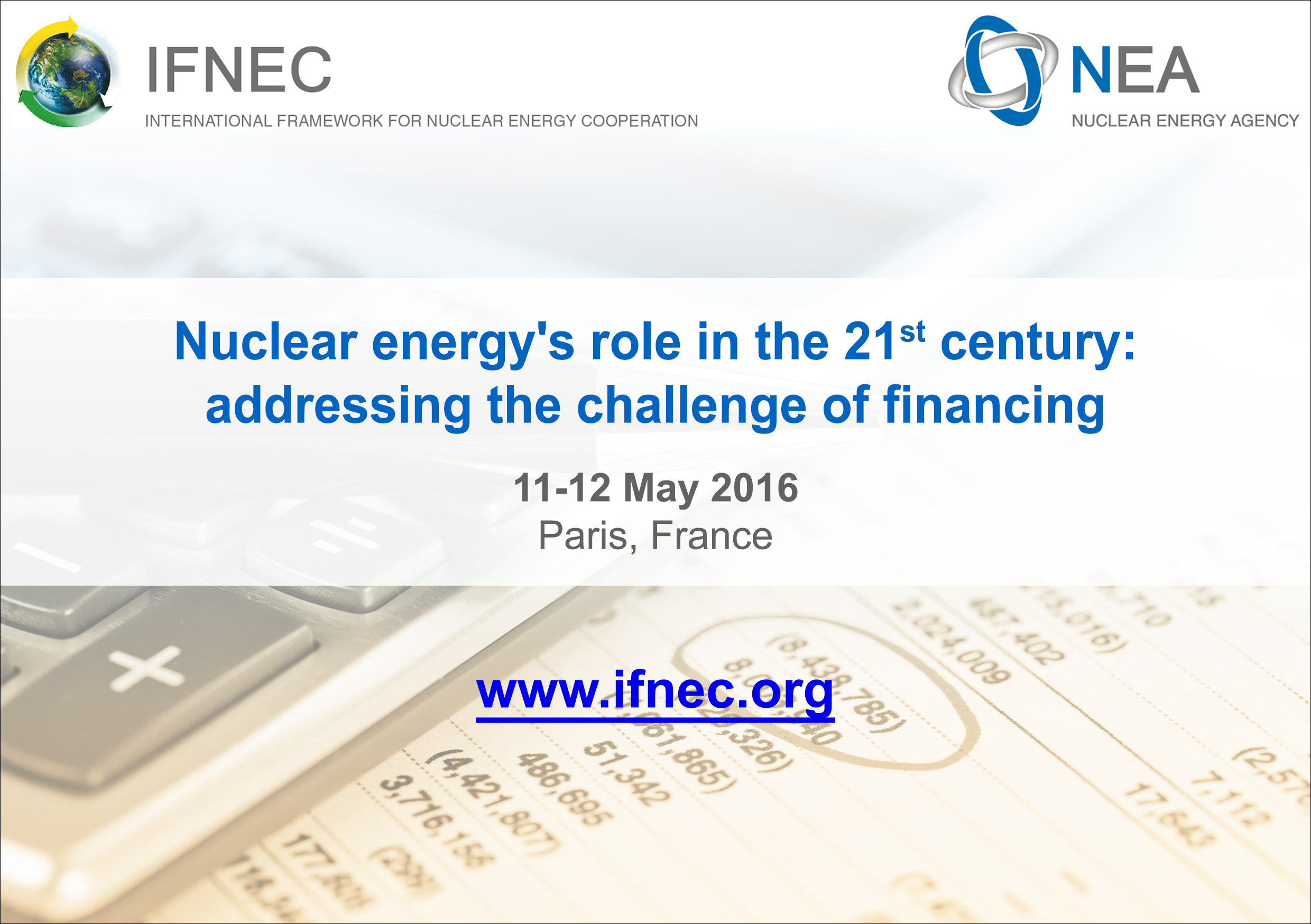 Nuclear energy's role in the 21st century: addressing the challenge of financing
Nuclear energy's role in the 21st century: addressing the challenge of financing
The International Framework for Nuclear Energy Cooperation (IFNEC) and the NEA will organise a conference on the financing of nuclear power plant projects on 11‑12 May 2016 in Paris, France. The conference, by invitation only, will convene leading stakeholders from energy planning authorities, regulators and export credit agencies, as well as vendors, utilities, bankers, rating agencies and insurers, to identify key barriers and develop implementable approaches to address the financing of nuclear projects. For additional information or to request an invitation, please see the IFNEC website.
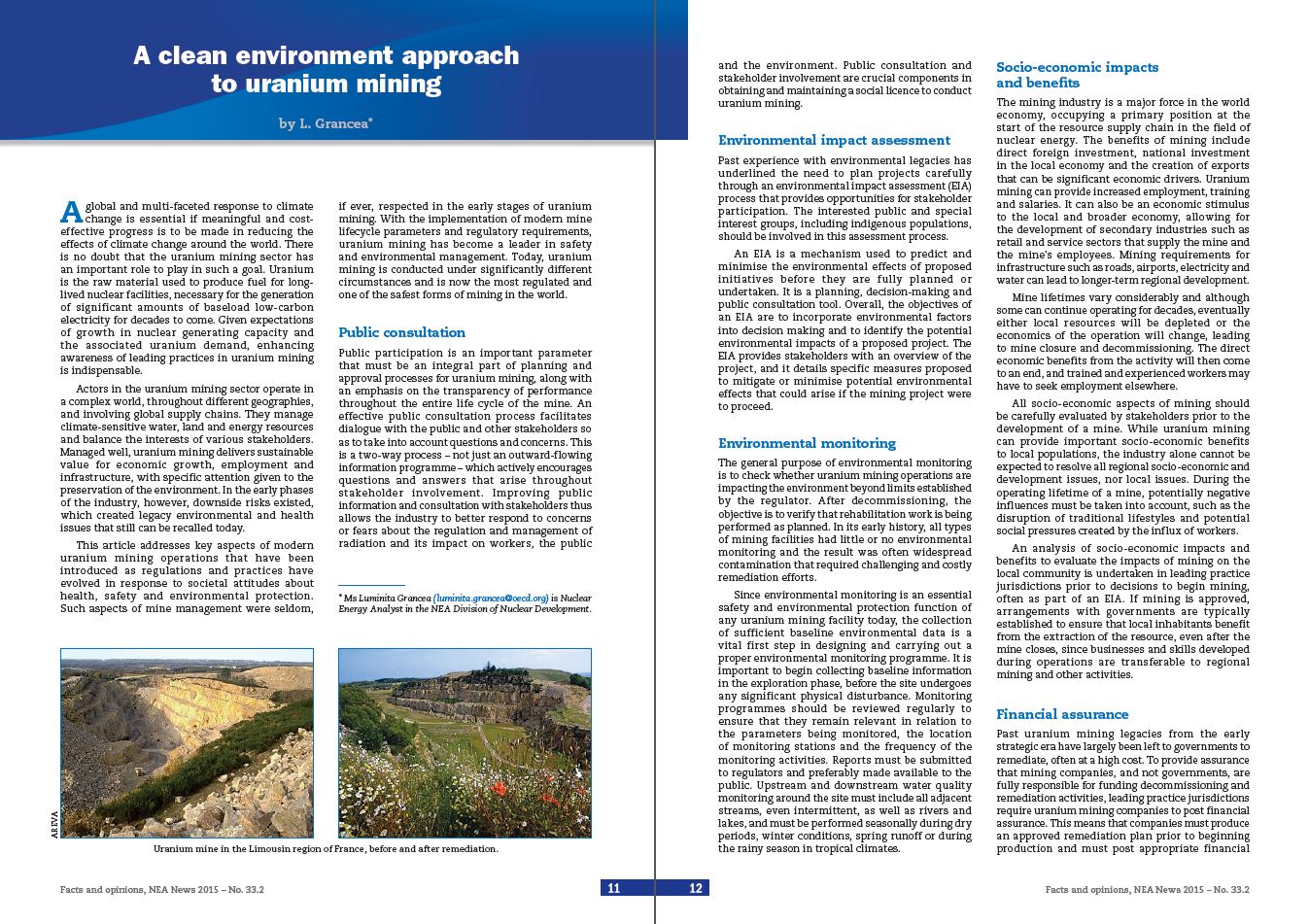
A global and multi-faceted response to climate change is essential if meaningful and cost‑effective progress is to be made in reducing the effects of climate change around the world. There is no doubt that the uranium mining sector has an important role to play in such a goal. Uranium is the raw material used to produce fuel for long‑lived nuclear facilities, necessary for the generation of significant amounts of baseload low-carbon electricity for decades to come. Given expectations of growth in nuclear generating capacity and the associated uranium demand, enhancing awareness of leading practices in uranium mining is indispensable. See this article for information on the key aspects of modern uranium mining operations that have been introduced as regulations and practices have evolved in response to societal attitudes about health, safety and environmental protection.
Optimisation of radiological characterisation and decommissioning
On 21-22 March 2016, the NEA Task Group on Radiological Characterisation and Decommissioning (TG-RCD) held its fourth meeting. In 2015 the group carried out a survey of NEA member countries to collect information on their experience and knowledge in radiological characterisation. Building on the conclusions of the survey and the collected case studies, as well as on the papers and presentations from the International Symposium on Preparation for Decommissioning (PREDEC2016), the group will prepare a status report with up-to-date information and recommendations to consider on the selection and tailoring of strategies for optimising radiological characterisation in nuclear decommissioning projects, especially from a waste and materials end-state perspective. The report is expected to be issued in 2017 and will draw on recent decommissioning characterisation experience to describe good practices for initiation and planning, implementation and data assessment, and evaluation and review.
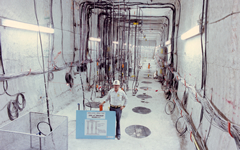 Progress on rock salt scientific studies
Progress on rock salt scientific studies
The NEA Salt Club held its annual meeting on 22 March 2016 to review the progress of its scientific activities. The Salt Club is a technical expert group dedicated to gathering scientific evidence for developing geological disposal facilities for radioactive waste in rock salts. During the meeting, the group discussed the results of actinide-borate interactions and the challenges involved in deriving a comprehensive thermodynamic model. Participants also examined the specific difficulties encountered due to complex interactions. A separate microbial task group additionally confirmed the presence of sulfate-reducing bacteria (SRB) in salt dome caprock, but noted insufficient data to prove the existence of SRB in subterranean salt formations. In reviewing its achievements to date, the group concluded that geo-mechanical integrity analyses remain a key element in assessing the long-term performance of salt repositories. The group will focus its 2016 studies on long‑term salt deformations and consolidation of crushed salt.
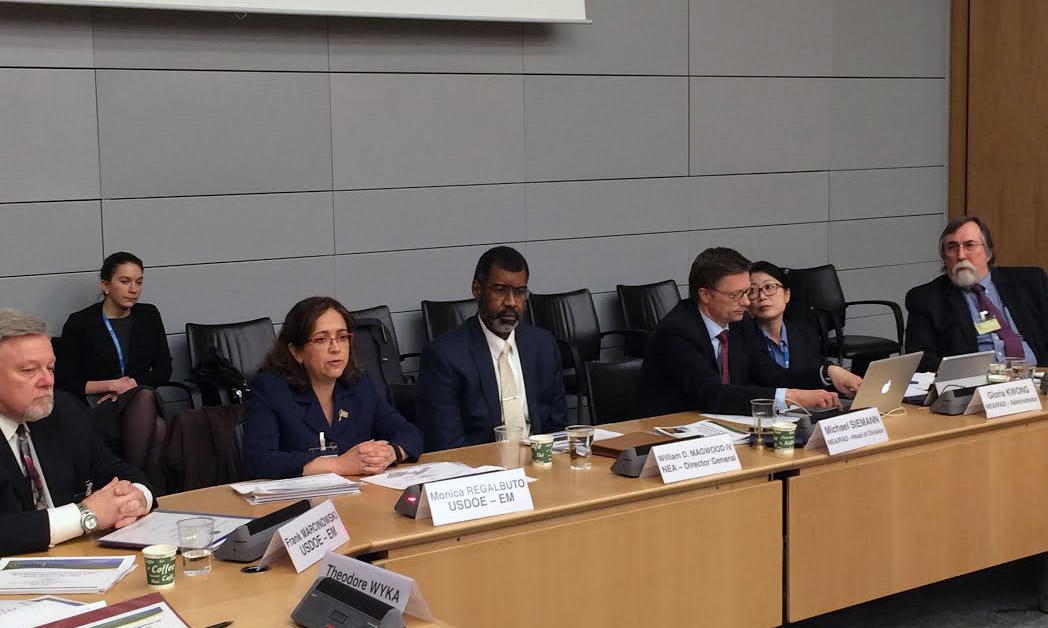 NEA Seminar on Lessons Learnt from the Waste Isolation Pilot Plant (WIPP)
NEA Seminar on Lessons Learnt from the Waste Isolation Pilot Plant (WIPP)
Recognising the importance of safety culture and the impact of managerial and human factors on safety performance in the management of radioactive waste, the NEA held a seminar on 31 March 2016 to examine the lessons learnt from the accidents that occurred at the Waste Isolation Pilot Plant (WIPP) in 2014. Located in southeast New Mexico, the WIPP is the only deep geological repository for permanent disposal of transuranic waste in the United States. In February 2014, two isolated events – a fire and a radiological release – took place at the WIPP, triggering a rigorous accident investigation process. The NEA seminar reviewed the danger of complacency in the workplace and discussed means to create a safety-focused organisation. The meeting discussions also revealed the effectiveness of social media as a communication tool. Participants underlined that emergency communications need to be open and transparent with the public in order to be effective and efficient.
Stakeholder dialogue on radiological protection: Phase 2
Between November 2011 and September 2015, the International Commission on Radiological Protection organised a series of 12 stakeholder dialogue meetings with individuals affected by the Fukushima Daiichi nuclear power plant accident who expressed their views on topics affecting their lives. Discussions focused on recovery, addressing topics such as the protection of children, the management of contaminated food, monitoring and self-help measures. The NEA supported the dialogues and attended all 12 meetings to directly listen to the concerns of affected individuals and to draw lessons for the NEA Committee on Radiation Protection and Public Health (CRPPH). A report summarising the lessons learnt will be submitted to the CRPPH for approval in April 2016. The success of these meetings has prompted radiological experts from Fukushima Medical University (FMU) to start Phase 2 of the dialogue initiative and the first meeting took place on 12-13 March 2016 in Miyakoji, the first municipality within the 20 km evacuation zone whose residents were allowed to return. Roughly 80% of the population has returned and almost half of those who were farmers have resumed farming. FMU plans to continue organising Phase 2 meetings and the NEA looks forward to bringing further lessons to the CRPPH through its participation in these meetings.
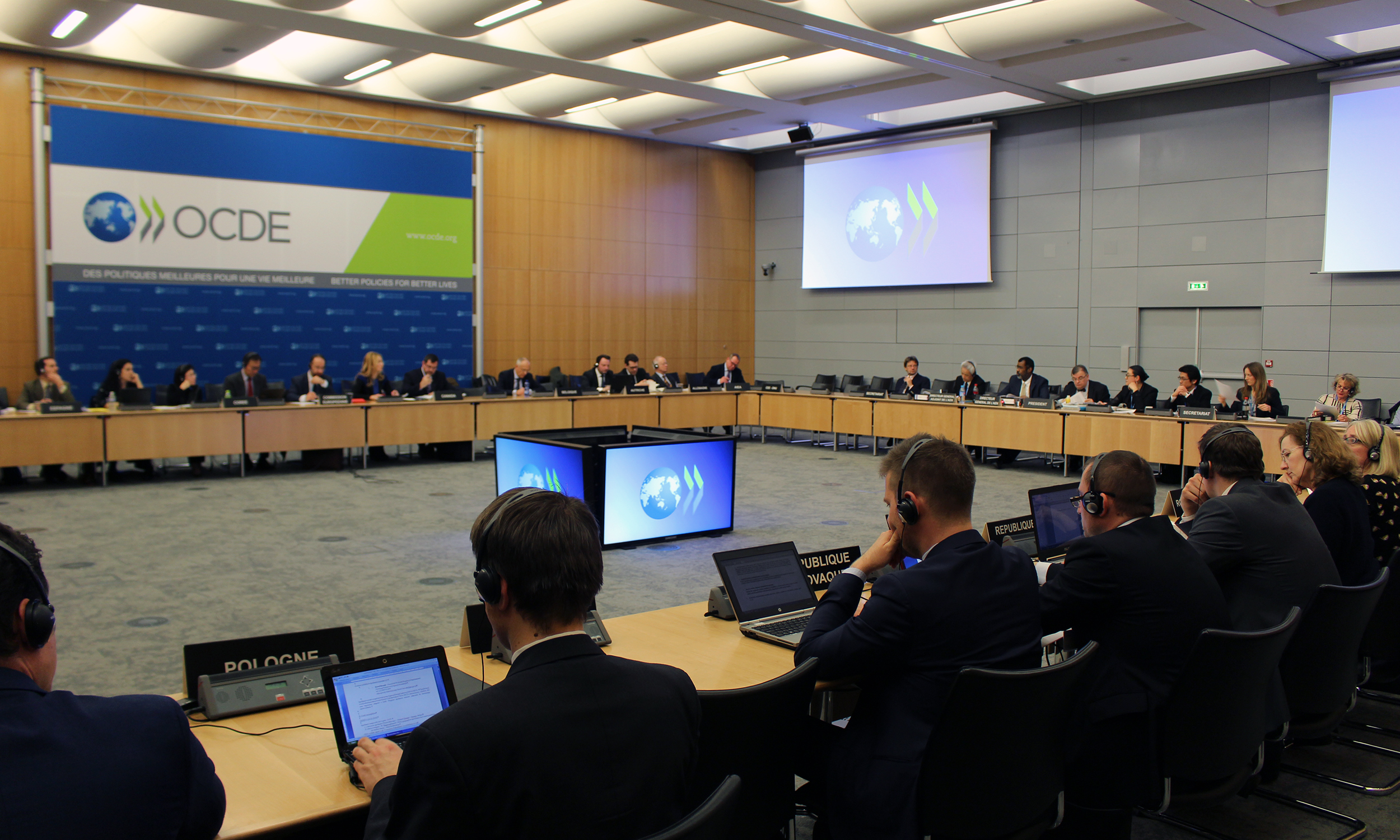
The NEA Nuclear Law Committee (NLC) met on 23‑24 March 2016, bringing together over 60 experts from member countries and international organisations, including the European Commission (EC), the International Atomic Energy Agency (IAEA) and the United Nations Economic Commission for Europe (UNECE), as well as representatives from non‑member countries (India and Lithuania). Participants at the meeting exchanged information on the latest national developments in nuclear law and discussed the current activities conducted under NLC auspices, such as the NEA educational and publication programmes in this area. The meeting also included discussions on stakeholder involvement and on nuclear liability, more particularly on the Paris Convention on Third Party Liability in the Field of Nuclear Energy and the related Brussels Supplementary Convention. Finally, a topical session was organised to discuss national frameworks for the authorisation of long-term operation of nuclear installations and for judicial challenges to licensing decisions.
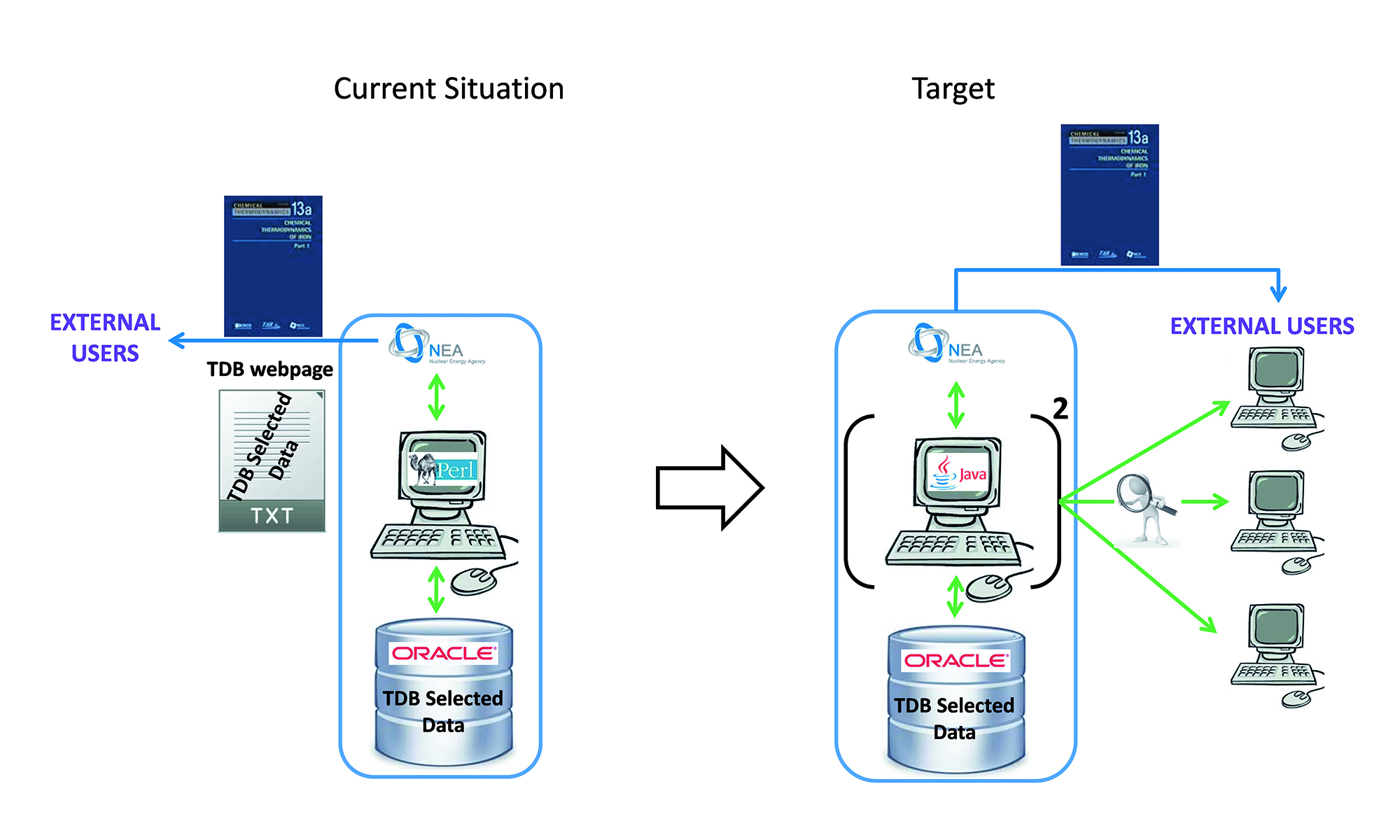 Towards the renewal of the NEA Thermochemical Database
Towards the renewal of the NEA Thermochemical Database
The NEA Thermochemical Database (TDB) Project was created three decades ago as a joint undertaking of the NEA Radioactive Waste Management Committee and the NEA Data Bank.The project involves the collection of high-quality and traceable thermochemical data for a set of elements (mainly minor actinides and fission products) relevant to geophysical modelling of deep geological repositories. Following the recent recommendations of the Task Force on the Future Programme of the NEA Data Bank to enhance scientific expertise and user services, a renewal of the software managing the TDB database is being undertaken. The main goal of the renewal is to meet the technological standards of modern thermochemical databases, including the preparation of a thorough documentation of the technical and functional features of the tool, and to envisage greater flexibility and options for end users, accompanied by a more robust and reliable management of the data to facilitate its maintenance. For an overview of the main axes of improvement, see this article.
22-MAR-16 |
COBRA-SFS CYCLE 4, Code System for Thermal Hydraulic Analysis of Spent Fuel Casks |
|
18-MAR-16 |
ZZ-VITJEFF32.BOLIB, JEFF-3.2 Multi-Grp Coupled (199n+ 42gamma) X-Sec. Lib. in AMPX Fmt for Nuclear Fission Applications |
|
16-MAR-16 |
MEGA, Mechanistic and Engineering Fission Gas Release Model for a Uranium Dioxide Fuel |
An online archive of previous editions is available here.
The monthly bulletin only lists new and updated material. It is distributed by e-mail to registered users of the Nuclear Energy Agency's Online Services. Registration is free; please use this link.